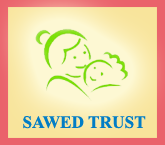
A vast majority of the rural poor continue to be dependent on land and water resources for their meager livelihoods. Sadly, however, various phenomena including deforestation, drought and soil erosion have resulted in decreased incomes for these families. Chronic poverty persists thus SAWED devotes a significant part of its intervention efforts on developing land and water resources. The aim is to enhance productivity, incomes and sustainable livelihoods.
Towards this objective, SAWED promotes the Integrated Natural Resources Management (INRM) of land, water, forest and biological resources to achieve and sustain potential agricultural productivity. INRM combines managing the use of natural resources along with their conservation and sustenance. Programmes comprise of enhancing productivity in agriculture; diversifying into new crops; setting up irrigation systems; and instituting entirely new ways of managing the natural resource base.
Sustainable Agriculture:
Agriculture is the primary source of livelihood in the regions where SAWED works. With current low levels of productivity in agriculture, SAWED extends assistance in finding opportunities to enhance livelihoods. Over half of SAWED’s livelihood programmes being focused on agriculture, its improvement – and the overall management of natural resources – remains key in the battle against endemic poverty in the rural areas.
Enhancing productivity and diversification are the core strategies of SAWED’s agriculture programmes. Specific activities are increasing the productivity of the main cereal crops to improve food security, and diversification into cash crops such as pulses, oil seeds, and vegetables. Whichever programme is undertaken, SAWED seeks to ensure its sustainability. In order to achieve this, the organisation trains and deploys a large number of agriculture extension entrepreneurs to the field. Producers’ institutions around agriculture are formed and strengthened as well.
Horticulture:
Horticulture is gradually emerging as a significant livelihood programme in the high-rainfall regions where SAWED is engaged. Diversification has become an essential component of sustainable strategies, given the dwindling productivity of agriculture. Critical to the success of SAWED’s horticulture programmes is the enhancement and management of natural resources, particularly in the hilly regions with limited potential for reliable irrigation.
SAWED teams, fielded in the undulating and hilly terrains, are working to encourage farmers to take up vegetable cultivation on their small-scale homesteads and near dug wells. These activities provide the poor families with a dependable source of income. SAWED has taken up fruit tree plantation programmes on private lands.
Land & Water Resources Development and Management:
At the heart of SAWED’s strategy has always been to work directly with the rural poor, build their capabilities, and introduce and develop new livelihood opportunities. While the organisation’s strategies, programmes, and methodologies have evolved over time, developing land and water resources has been a fixture in SAWED’s work.
SAWED takes the integrated approach to resource management and has demonstrated ways to promote the development of natural resources. This approach leads to an equitable and sustainable economic growth, ensures household food security, and helps minimise mass poverty. An integrated approach to land and water resources management requires participatory planning with the people, to develop systems and treatment measures that are most suitable to the resources available. The technologies that SAWED has developed are simple and labour intensive and best suited to the people they are designed to serve.
SAWED’s integrated approach to natural resource management (INRM) calls for the efficient management of soil, water and vegetation resources, yet maintaining a livelihood focus. INRM recognises that uncontrolled, unplanned and unscientific use of natural resources results in their decline. Therefore, managing natural resources calls for proper land use while protecting it from erosion; enhanced productivity while maintaining soil fertility; and water harvesting and conservation. INRM not only optimises the productivity of land and water resources, but also helps fight mass poverty. In other words, sustainable development efforts must take into account the relationship between the needs and priorities of the people, and natural resources.
Training Programme to small and marginal farmers:
SAWED conducts training programme to small and marginal farmers on regular interval. The purpose of training is to familiarize farmers with modern conservation practices. This will raise the awareness of community on causes and consequences of environmental degradation and initiate the community to involve in sustainable agriculture and natural resource conservation activities.
Traditional Seed Conservation:
Plots are chosen in project areas where indigenous varieties are multiplied in-situ. This is done in addition to multiplying grain varieties in the farmer’s fields. This in-situ centre also serves as a demonstration plot. It also enables us to multiply varieties which are rare and those varieties where the quantity of seeds are less.
Organic Farming:
Most of the farmers have lost much of their ancestral farming knowledge and ancient seed varieties since the introduction of chemical based commercial agriculture and hybrid seeds. Because of all these, land lost its fertility and it leads to heavy loss for small farmers and it affects whole community in the villages. SAWED is engaged in developing feasible and user-friendly programs to help farmers go organic. Revitalizing and strengthening the farmer’s faith in traditional eco-friendly technologies is the only way to ensure that the agricultural community turns to organic farming as a sustainable, long term solution. It is important to clearly understand what technologies can be used, if and how they need to be modified, and what needs to be discarded as unsuitable for our situation.
We realize the need to develop and offer solutions that can be implemented quickly and easily, so that the farmer can start reaping the benefit without going through too long a transition period. Through our initiatives, we have successfully turned a significant number of farmers in the region to organic farming methods. By providing solutions that work, we demonstrate to the farming community that non-chemical methods are the only way forward.
Seed Bank:
Our community seed bank project is aimed at identifying important traditional seed varieties and orienting the agricultural community towards conserving and cultivating them. Currently, we are focusing on indigenous paddy and vegetable varieties. Our main aim is to enhance the livelihood security of small and marginal farmers through conservation of indigenous genetic resources.
To support our projects/Contribute your donation to:
| 1. | To provide one pair goat to one underprivileged/tribal/dalit small farmer. | INR 11000 | US $ 183 |
| 2. | To provide one milch animal/Cow to one underprivileged/tribal/dalit small farmer. | INR 21000 | US $ 350 |
| 3. | To provide agricultural implements to one underprivileged/tribal/dalit small farmer. | INR 5000 | US $ 83 |
| 4. | To provide seeds to one dryland small farmer for cultivation. | INR 5000 | US $ 83 |
| 5. | To provide 100 fruit seedlings to one underprivileged/tribal/dalit small farmer to promote horticulture. | INR 15000 | US $ 250 |
| 6. | To provide one vermi compost unit to one village farmers group. | INR 300000 | US $ 5000 |
| 7. | To conduct sustainable agriculture training programme for 30 small farmers. | INR 25000 | US $ 420 |

